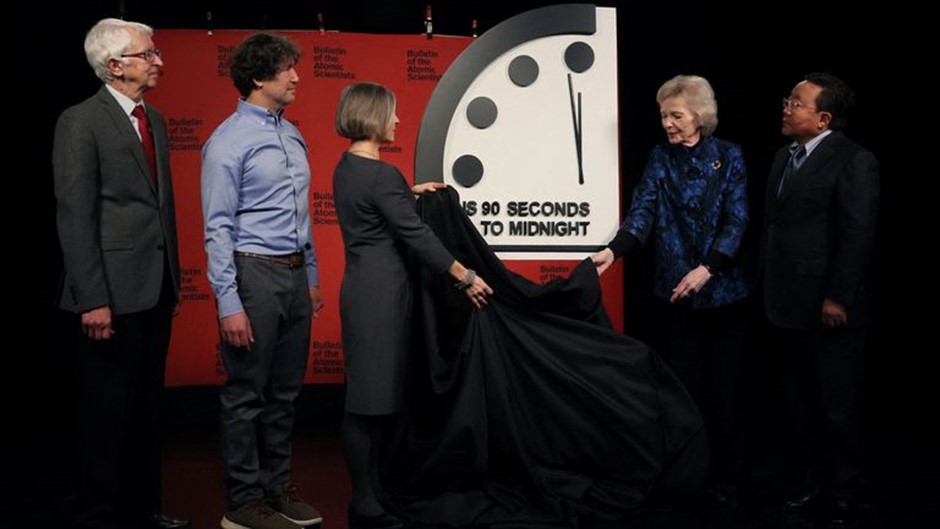Hey there, fellow Earthlings! Today, let’s talk about something that might sound straight out of a science fiction novel but is as real as it gets: “The Doomsday Clock.”
Simply put, the Doomsday Clock symbolises humanity’s proximity to global catastrophe, representing humanity’s movement to possible obsolescence.
But how does the clock work? Who determines the time? And how does climate change play a role? These and more are the answers you will find in this article.
What is the DoomsDay Clock?
Established in 1947 by the Bulletin of the Atomic Scientists, a Chicago-based non-profit organisation, the Doomsday Clock symbolises humanity’s proximity to global catastrophe.
Initially conceived to gauge the threat posed by nuclear weapons, the clock’s hands now encompass a broader array of existential risks, with climate change looming ever larger on its horizon.
The parallels between nuclear annihilation and climate catastrophe are striking. Both phenomena possess the capacity to disrupt ecosystems, displace populations, and destabilise geopolitical landscapes.
However, while the threat of nuclear war remains a persistent concern, the spectre of climate change looms as an insidious, slow-motion disaster with far-reaching consequences.
How Does the Clock Work?
The Doomsday Clock is a visual metaphor for existential threats facing the world, with midnight representing the theoretical point of annihilation. The threats that could lead to such a scenario include political tensions, advancements in weapons and technology, climate change, and pandemic illnesses.
Scientists who assess existential risks at a given time determine the position of the clock’s hands, either closer to or further away from midnight. The Doomsday Clock is updated annually based on information regarding catastrophic risks to the planet and humanity.
Midnight on the Clock signifies the theoretical point of annihilation, a catastrophic scenario of nuclear conflict or irreversible climate change, with devastating consequences for humanity.
The Doomsday Clock’s closest brush with midnight occurred during the Cold War, symbolising the point of no return for humanity and the planet. But it has never struck the fateful hour.
Who decides what time it is?
Initially overseen by Bulletin editor, Eugene Rabinowitch, the responsibility for setting the Doomsday Clock’s time has since been entrusted to the Bulletin’s Science and Security Board (SASB). Composed of 18 leading experts from various fields, including policy, diplomacy, military history, nuclear science and climate science, including Nobel Laureates, this group deliberates annually to determine the clock’s position.
Their assessment involves rigorous discussions of world events, considering various factors such as geopolitical tensions, technological developments, and environmental challenges that pose catastrophic risks.
They culminate in the placement of the clock’s hands to signify the current level of danger.
Origins and Evolution of the Doomsday Clock
The clock’s inception traces back to 1947 when a group of atomic scientists, also known as the Manhattan Project Scientists from World War Two era, including physicist Leo Szilard, developed it.
Concerned about the potential devastation wrought by nuclear weapons, Szilard and fellow Manhattan Project scientists convened in September 1945, leading to the establishment of the Bulletin of the Atomic Scientists. The Bulletin of the Atomic Scientists was founded to raise awareness about the perils of nuclear proliferation.
With a growing readership, co-editor Hyman Goldsmith enlisted the talents of artist Martyl Langsdorf to craft a cover design for the June 1947 issue. Martyl, married to physicist Alexander Langsdorf, who had been involved in the Manhattan Project, conceived the notion of depicting a clock indicating the urgency of addressing atomic weaponry. Thus, the Doomsday Clock was born.
Over its more than 75-year history, the clock has varied in its proximity to midnight, ranging from seven minutes to 17 minutes, reflecting periods of heightened tension or relative stability, such as during the Cold War and the signing of arms reduction treaties between the United States and the Soviet Union.
What Time are We Now?
In recent years, the Doomsday Clock has witnessed significant shifts, mirroring the evolving geopolitical landscape and the emergence of new threats.
As of the latest update in 2023, the Doomsday Clock stands at 90 seconds to midnight, the closest it has ever been. This adjustment, from its previous position of 100 seconds to midnight in 2020, signifies heightened concerns about global security.
The decision to move the clock forward was influenced significantly by Russia’s invasion of Ukraine, which has reignited fears of nuclear conflict.
However, while the war in Ukraine played a significant role, it was not the sole factor contributing to the clock’s adjustment. Rather, the setting of the clock serves as a multifaceted reflection of global challenges, including nuclear proliferation, climate change, and other existential risks.
What roles does Climate Change play?
The Bulletin’s decision to factor climate change into its assessment reflects the growing recognition of its significance as a global threat multiplier. Rising global temperatures, extreme weather events, and environmental degradation represent immediate dangers and long-term existential risks to humanity.
While it’s tempting to interpret a static position as a sign of relative calm, such complacency is unwarranted as seen in the recent decision to maintain the clock at 90 seconds to midnight. On the contrary, the lack of movement does not equate to stability. Rather, it underscores the persistent threats posed by nuclear proliferation, geopolitical conflicts, and the escalating climate crisis.
Rachel Bronson, director of the Bulletin, explains that while the effects of climate change may not be as immediately tangible as those of a nuclear war, they pose existential risks with irreversible consequences.
A Glimmer of Optimism amid the Gloom
Despite the gravity of the situation, it’s important to understand that the purpose of the Doomsday Clock is not to instil fear but to galvanise action. The striking of midnight on the Clock serves as a call to action, reminding us of our collective responsibility to safeguard the future of our planet and ensure the survival of generations to come.
The key lies in proactive engagement and advocacy for change, emphasising that it is not too late to alter the course of history and prevent civilization-threatening outcomes.
Fortunately, there is still hope. The growing momentum of the climate movement, coupled with advancements in renewable energy technology and sustainable practices, offers a glimmer of optimism amid the gloom. From grassroots activism to international agreements such as the Paris Agreement, there are signs of progress in the fight against climate change.
However, time is of the essence. The window of opportunity to avert the most catastrophic impacts of climate change is rapidly closing. Our decisions today will reverberate for generations to come, shaping the fate of humanity and the planet we call home.
Photo credit: Sky News
Found it interesting and would like more in the mail?




